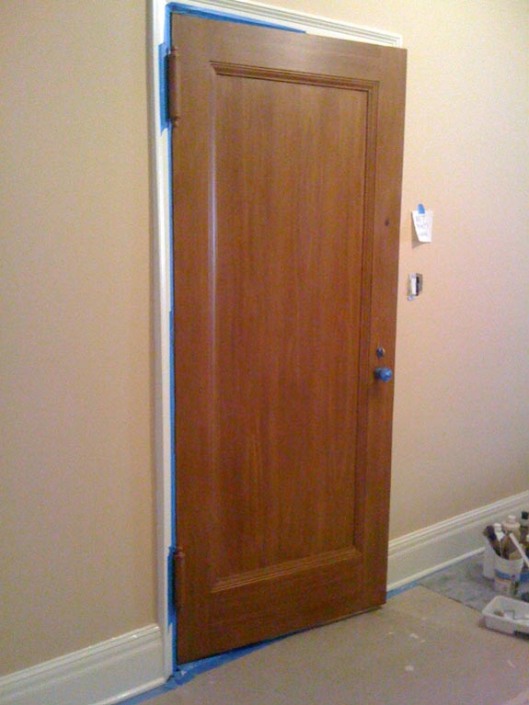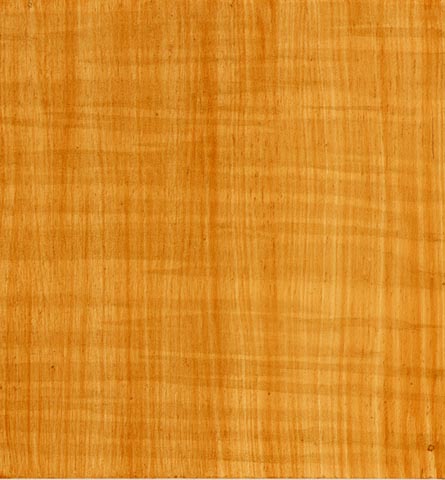Tags
decorative painting, faux finish, faux woodgrain, interior design, mahogany, oak, rosewood, woodgrain
Apartment doors in New York City have to meet two criteria: they must be fireproof and self closing. A fireproof door can be either a kalamein door, which is wood wrapped in steel, or a hollow core steel door, which is found in newer construction. So no matter where you live, whether on Fifth Avenue or in a tenement building, your front door is made of steel.
What does this have to do with painting wood, you ask? Lots! If you own a gorgeous apartment and your foyer is paneled in mahogany and furnished with all sorts of swanky stuff and your front door is ugly old steel, what do you do? You paint your door to look like the wood in the rest of your foyer, that’s what.
This door has been painted to look like mahogany. The molding is painted as well, to create a 3-D, or trompe l’oeil, effect.
Painting doors as wood grain is one of my favorite projects, and has always been a steady source of work. No matter how much design trends come and go, a front door that’s made of wood (or appears to be) is always beautiful.
This door matches the simple wood closet doors in this entry foyer.
Painting wood seems complicated, but it’s actually not. It’s about two basic things, pattern and color, and once you understand how to see wood in this way, you can imitate almost any wood.
Most woods can be broken down into three layers: the flogging layer, which represents the pore structure, which are the tiny dots that are found in almost every wood; the figure grain, which is the pattern created by the sap; and the toning layer, which is the overall color of the wood. Each layer has a different color and pattern. Therefore, if you can look at the real wood you’re matching and can recognize and visually separate the color and pattern of each of these layers, you can paint them. And if you’ve seen it all correctly, when the layers combine, voila! Wood. Obviously this takes a bit of practice, but once you get it, you’ve got it.
In this working sample, each layer was taped off after completion, so you can see how layers and color build up to create a pattern. In this sample, a fourth layer called the crossfire layer was added. Notice the color of the base coat in relation to the final result. The base coat is always lighter than the final finish while tilting toward the wood’s deepest color. Most woods receive a final coat of varnish as well.
Each layer uses different brushes to create a specific pattern. Here’s a quick sequence of the process of painting a dark straight grain mahogany. I paint wood grain using water-based glaze.
The sample board is painted in a terra cotta colored latex base coat.
The glaze is applied with the chip brush on the right, then flogged with the flogging brush on the left.
The dried flogging layer.
Next, the figure layer glaze is applied. In this case, the figure is a straight grain, so it’s a simple downward drag of the chip brush on the right. The pattern is softened with the badger brush on the left.
Here’s a close up.
The layer needs to dry before continuing. Finally, the overglaze of the toning layer. This is a dark one. The base coat is much lighter so that there’s contrast between the colors, which helps the wood gain depth. The overglaze is applied with a soft spalter brush.
Again, the glaze is softened with the badger brush.
Once the glaze is dry, the surface is varnished with an oil-based satin varnish for more depth and protection.
Here’s another straight grain mahogany in a redder version.
This is a sample of a browner mahogany figure grain.
This wood is anigre. It’s painted with the fourth layer of crossfire over the toning layer.
This is a close up of painted rosewood. I love this wood, it’s so pretty. You can clearly see the specks of the pore structure here.
Wood doors are almost always painted to match other wood in the room and because of this, they are often assumed to be real. Sometimes faux wood molding is painted on as well, as shown in the first photo. Painted wood grain will almost always be mistaken for real wood if it’s painted where one would expect to find real wood. If you’d like to learn more about our lazy brains, it’s explained here in my post about trompe l’oeil.
This is an interior door made of wood. Unfortunately, it was made of the wrong type of wood. I painted it to match the surrounding oak cabinetry of the bathroom. Here you see the completed pore and figure layers.
Here the door is complete, with the final toning layer and varnish.
This is a close up of painted oak.
If you live in an elevator building, the elevator doors are made of steel, too. If you’re lucky enough to have an elevator that opens directly into your apartment, then you may want those doors to match your foyer or entry vestibule as well.
The real wood door is on the left; the painted elevator doors, with faux moldings, on the right.
So the next time you’re in New York, standing in front of an elevator door or an apartment door and you think you’re looking at real wood, look again… you may be wrong!






















